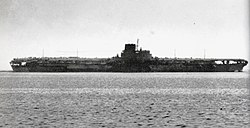Aircraft carrier
| Wikimedia Commons has media related to Lua error in Module:Commons_link at line 62: attempt to index field 'wikibase' (a nil value).. |
Aircraft carriers are warships that carry airplanes and other aircraft like helicopters. They are used by navies to allow aircraft to fight along with naval warships. Aircraft carriers are usually very large, carrying hundreds or thousands of sailors and tens or hundreds of aircraft.
The top of an aircraft carrier is called the flight deck and looks like a very small airport. Old aircraft carriers carried airplanes that could takeoff and land in the short distance of the flight deck without help. Similarly, small modern aircraft carriers only carry helicopters or specially designed airplanes such as the Harrier that can take off and land straight up and down or in the short distance of the flight deck.[1]
The flight deck of a large, modern aircraft carrier has a landing area and a take-off area. The landing area is in the back and has a short runway. Airplanes stop by using a hook on the back of the airplane to grab wires stretched across the runway.[2] In the front, the flight deck has a steam-powered catapult that connects to the front wheel of an airplane.[3][4] The catapult pulls and throws the airplane off the deck, helping it take off quickly. So, aircraft carriers are basically small, floating, mobile airports.
Because they are big ships and need much electric power, big modern aircraft carriers are steamships. Some have on-board nuclear power plants[5][6] Others burn fuel oil.
Except for their airplanes, aircraft carriers usually have few weapons, so other warships escort them. Together, the aircraft carrier and these warships form a carrier group.
Aircraft Carrier Media
Four modern aircraft carriers of various types—USS John C. Stennis, Charles de Gaulle (French Navy), USS John F. Kennedy, helicopter carrier HMS Ocean—and escort vessels, 2002
French aircraft carrier Charles de Gaulle (rear), and US Navy carrier USS Ronald Reagan conducting joint operations in the Persian Gulf; both with the CATOBAR configuration.
USS Abraham Lincoln (CVN-72) a United States Navy fleet carrier, also often referred to as a supercarrier, seen here underway in 2019 crossing the Atlantic.
Aircraft Carriers in the STOVL configuration are in service with Italy, Spain, Thailand and the United Kingdom.
The Royal Navy's HMS Ark Royal in 1939, with Swordfish biplane bombers passing overhead. The British aircraft carrier was involved in the crippling of the German battleship Bismarck in May 1941
The Japanese seaplane carrier Wakamiya conducted the world's first naval-launched air raids in 1914.
The Japanese carrier Shinano was built on a battleship hull to carry spare aircraft and ordnance in support of other carriers. En route to complete fitting out it was sunk by an American submarine.
F/A-18 Hornet aircraft landing video
References
- ↑ Duffner, Robert W. (March–April 1984). "Conflict in the South Atlantic: the impact of air power". Air University Review. Maxwell Air Force Base, Alabama: Department of the Air Force. ISSN 0002-2594. Archived from the original on 10 January 2010. Retrieved 18 November 2017.
- ↑ "Carrier Arresting Gear: It all Began With Sandbags". navalaviationnews.navylive.dodlive.mil. 19 November 2013. Archived from the original on 17 April 2021. Retrieved 25 February 2023.
- ↑ "¤ A C A M ¤ Connexion". www.acam.asso.fr. Archived from the original on 8 August 2017. Retrieved 24 April 2018.
- ↑ "Launch and Recovery: From Flywheels to Magnets". navalaviationnews.navylive.dodlive.mil. Archived from the original on 2015-11-25. Retrieved 2015-11-24.
 This article incorporates text from this source, which is in the public domain.
This article incorporates text from this source, which is in the public domain.
- ↑ "Nuclear-Powered Ships | Nuclear Submarines". world-nuclear.org. Archived from the original on 25 September 2019. Retrieved 11 September 2019.
- ↑ Webster, Paul; Norton-Taylor, Richard (23 August 1993). "French Foil MI6 Carrier Snoop". The Guardian: 1.










